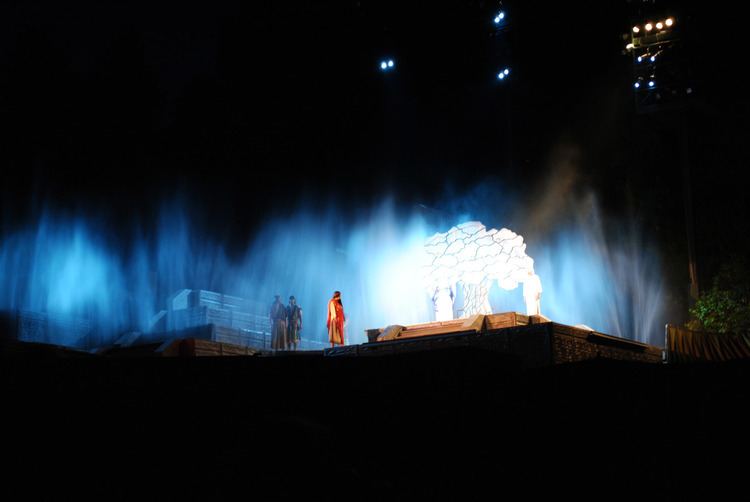Date premiered 1937 | ||
 | ||
Subject Ancient American events reported in the Book of Mormon, the visitation of Christ to the American continent following his resurrection, and the restoration of the Gospel in the latter days. Setting Foot of the Hill Cumorah in Palmyra, New York, United States | ||
The Hill Cumorah Pageant is an annual production of The Church of Jesus Christ of Latter-day Saints (LDS Church) staged at the foot of the Hill Cumorah in Palmyra, New York, United States. Premiering in 1937, it is considered to be the flagship pageant of the LDS Church. It depicts Joseph Smith's encounter with the Golden Plates (translated into English as the Book of Mormon), as well as a dramatization of the events recorded therein. The pageant features 700 cast members, 1,300 costumes, and a 10-level stage. It runs for seven nights in late July and attracts approximately 35,000 viewers annually. No donations are accepted and no tickets are required, although seating is first-come, first-served.
Contents
History
The pageant traces its roots back to the early 1920s and the "Cumorah Conference" of the Eastern States Mission, which was held each year annually in late July. Mission president B. H. Roberts would take some of his missionaries from New York City and travel to Palmyra and the recently acquired Smith Family Farm to celebrate Pioneer Day, acting out scenes from the Book of Mormon and LDS Church history as part of the commemoration. Over the next decade, the conference grew in duration and scale, and New York University English professor H. Wayne Driggs wrote the script America's Witness for Christ for the first official performance of the Hill Cumorah Pageant, which premiered on July 23, 1937.
The pageant advanced technologically over the next few decades, with stereophonic sound inventor Harvey Fletcher designing, building, and installing a five-track recording system; and Crawford Gates composing an original score for the pageant, which was recorded by the Mormon Tabernacle Choir and the Utah Symphony Orchestra in 1957. In 1973, LDS Church president Harold B. Lee visited the pageant and called for a phasing out of full-time missionaries in the pageant. Consequently, the cast has since consisted entirely of regular church members. In 1988, Orson Scott Card was tasked with writing a new script. He was instructed to make the script "accessible to a modern audience, targeting the non-scripture-reading, non-Mormon young adult," which he did in part by making the new version approximately 40 minutes shorter than the previous one.
In 1991, local service organizations were invited to provide snacks and meals to pageant visitors. The offer was accepted by Rotary International, Lions Clubs International, and Kiwanis International, which have turned the pageant into their primary annual fund-raising event. In 1997, Donny Osmond left his starring role in the tour of Joseph and the Amazing Technicolor Dreamcoat to participate with his family in the cast of the pageant. Osmond played the role of the prophet Samuel the Lamanite.
Brent Hanson, a faculty member at Dixie State University, has served as the pageant's artistic director since 2005. During the 2012 season, the pageant held festivities and reunions in commemoration of its 75th anniversary.
The New York Times contrasted the pageant's sincerity with the raucous tone of another major production, the satirical Broadway musical The Book of Mormon.
Scenes
The pageant is 70 minutes in duration and depicts the overarching story of the Book of Mormon, which Mormons believe Joseph Smith translated from Golden Plates he received from an angel on the Hill Cumorah itself. The pageant also includes the story of Smith's encounter with the angel, Moroni.
The script for the pageant is taken from the Bible and the Book of Mormon, including ten short story scenes:
- The Prophet Lehi
- The Visions of Christ
- The Building of a Ship
- The Voyage to Ancient America
- The Burning of Abinadi
- The Ministry of Alma
- The Prophecy: A Day, A Night and a Day
- The Resurrected Christ Appears to Ancient Americans
- The Written Word: A Golden Message
- The Restoration of Christ's Kingdom
Cast, setting, and special effects
The pageant's cast includes approximately 700 people. Prospective cast members, many from outside New York State, apply online between the previous August and November. Since the pageant soundtrack is prerecorded by professional actors, with singing by the Mormon Tabernacle Choir, cast members need only to memorize movements and follow cues. The show opens after only a week of intensive rehearsals, and it closes after seven performances.
Over 1,300 costumes are utilized for the pageant, which plays out on a 10-level stage. Special effects include earthquakes, floods, and fireballs.
There are 8,000 chairs available for audience seating in a large outdoor "bowl" at the foot of the stage, which is built on many levels up the side of the hill. Audience members may also bring their own chairs and blankets. Parking is available for 3,000 cars. The pageant attracts approximately 35,000 visitors annually.
